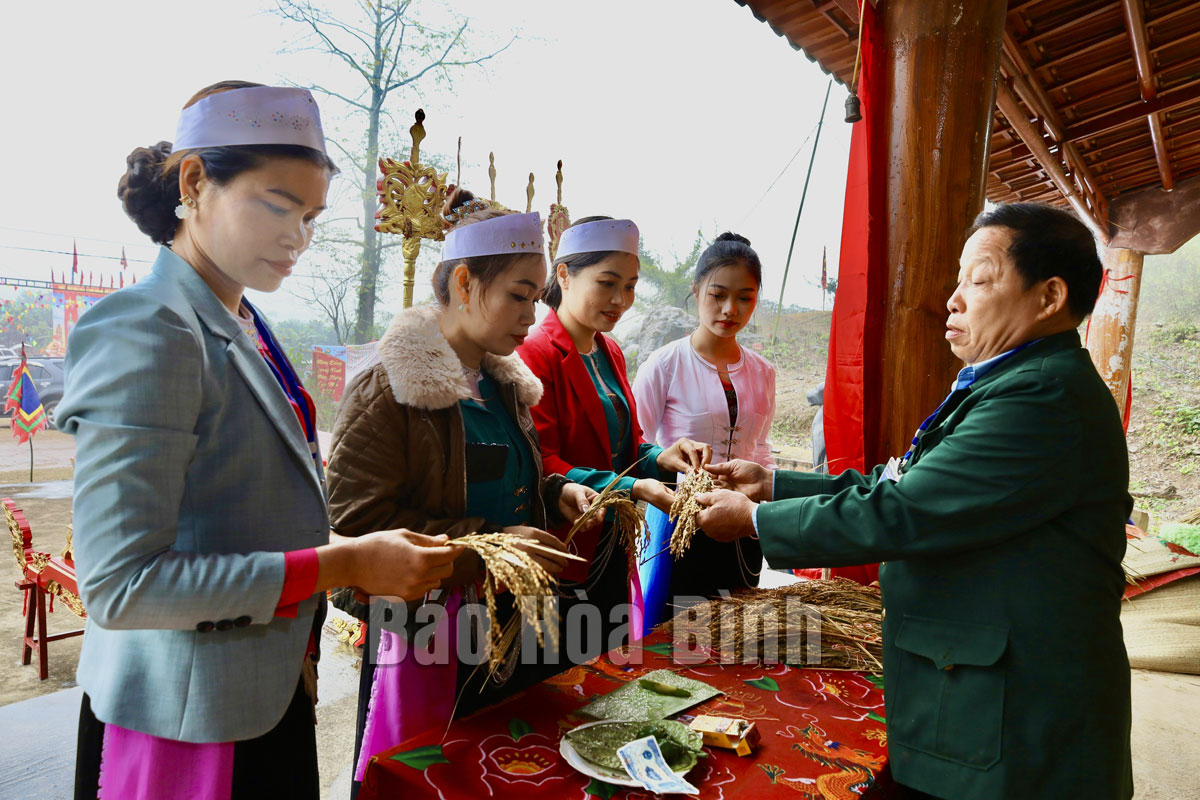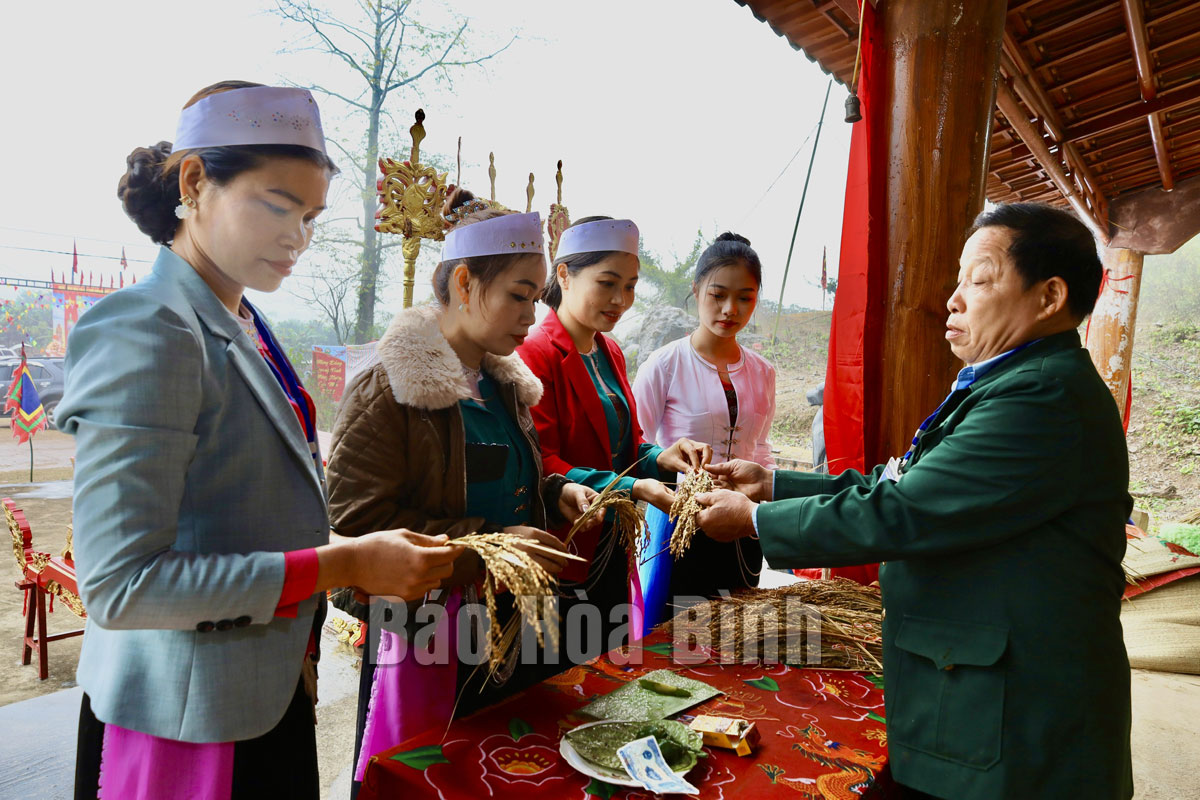
(HBO) – The preservation and promotion of ethnic groups’ cultural values are meant to help educate the public on history and fine cultural traditions, boost exchanges to enrich culture, build a healthy cultural environment, and help comprehensively develop people’s personality. In recent years, Lac Son district has effectively tapped into local cultural identities in tandem with boosting sustainable tourism development and improving people’s material and spiritual lives, thereby contributing to socio-economic development.
Residents in the Muong Vang area join the Khenh Communal House
Festival in Van Son commune to receive the year’s first rice ears which
symbolise good luck and health. This is a cultural characteristic of the
festival.
Making improvement in
cultural development, preservation
On December 20, 2021, the Party Committee of Lac
Son district issued Resolution No 08-NQ/HU on preserving and bringing into play
the Muong ethnic group’s cultural identity, showing its determination to
achieve the long-term targets on cultural development and preservation. On July
6, 2022, the district People’s Committee approved a project on preserving and
bringing into play ethnic groups’ cultural identities in Lac Son in the 2022 -
2025 period, with a vision to 2030. Local authorities have also implemented
Plan No 107/KH-UBND, dated August 22, 2022, to identify the tasks and
responsibilities of agencies, sectors, organisations, and localities while
engaging people of all social strata in cultural preservation and promotion.
Besides, Lac Son has classified intangible
cultural heritage; collected, preserved, and brought into play the ones at high
risk of falling into oblivion; compiled dossiers seeking authorised agencies’
recognition of such intangible cultural heritage as the Coi Communal House
Festival in Vu Binh commune, the Khenh Communal House Festival in Van Son
commune, the Voi swinging festival in Vu Ban town, the art of folk singing, and
the art of playing Muong gongs.
It has also continued seeking authorities’
granting of the People’s Artisan and Meritorious Artisan titles to local
artisans who have made great contributions to cultural preservation and
promotion. The district has increased the teaching of intangible cultural
heritage to young people, held exhibitions, and carried out a project on
building a space for preserving the Muong ethnic cultural heritage in Yen Phu
commune.
In terms of tangible cultural heritage, Lac Son
has assessed the value of relic sites and scenic landscapes to propose the
inclusion of those places in the district’s and province’s lists of the sites
entitled to protection. The ones with historical, cultural, and natural values
have been selected to build dossiers submitted to authorities for ranking.
Efforts have also been made to restore relic sites and develop attractive
destinations and tours.
In addition, Lac Son has devised mechanisms and
policies to encourage artisans to participate in preserving and bringing into
play cultural heritage values. It has also worked to improve the capacity of
cultural practitioners, especially artisans in the community, so that they can
serve as the core of cultural preservation and promotion.
Restoring, promoting
values
Aside from efforts by the local Party committee
and administration, residents in Lac Son have also been joining hands in
upholding traditional cultural values. Such outstanding cultural heritage
pieces as "mo Muong”, prayers to ancestors in festivals or anniversaries, the
"thuong rang bo meng” singing, Muong gongs, traditional musical instruments,
patterns on brocades, the weaving craft, and folk stories are still being kept.
People have also maintained traditional festivals, fine customs, folk knowledge
about literature and arts, traditional-style stilt houses, and traditional
craft villages. Local hamlets have also set up clubs to practice the Muong
ethnic culture.
Bui Van Duong, Vice Chairman of the Lac Son
People’s Committee, said authorities and people’s awareness of cultural
preservation and promotion is being improved, helping build a healthy cultural
environment and life.
The district targets that by 2025, 20% of the
local Muong people can write the Muong script, 85% will know how to wear
traditional costumes properly and worn them regularly on anniversaries, each
communal-level locality will develope at least one traditional craft village,
and each hamlet will have at least one club about the Muong culture.
In the long term, authorities will continue
stepping up cultural value preservation and promotion, propose relevant
agencies to honour more artisans, expand the scale of cultural, sports and
traditional festivals, and boost preserving traditional culture villages in
tandem with developing community-based tourism, the official added./.
With an increasingly vibrant and widespread emulation movement aimed at building cultured residential areas and cultured families, Yen Thuy District has been making steady progress toward improving both the material and spiritual well-being of its people, while fostering a civilized, prosperous, beautiful, and progressive community.
Once lacking recreational spaces and community facilities, Residential Group 2 in Quynh Lam Ward (Hoa Binh City) has recently received attention for the construction of a new, spacious, and fully equipped cultural house. The project followed the model of state support combined with public contributions in both labor and funding.
The "All people unite to build cultural life" movement, which has been effectively integrated with Kim Boi district’s socio-economic development goals, is fostering a lively spirit of emulation across local residential areas, hamlets, villages, public agencies, and enterprises. In addition, through the initiative, traditional cultural values are being preserved and promoted, while community solidarity and mutual support in poverty reduction and economic development are being strengthened.
A working delegation of the Hoa Binh provincial People’s Committee led by its Permanent Vice Chairman Nguyen Van Toan on June 11 inspected the progress of a project to build the Mo Muong Cultural Heritage Conservation Space linked to tourism services in Hop Phong commune, Cao Phong district.
Born and growing in the heroic land of Muong Dong, Dinh Thi Kieu Dung, a resident in Bo town of Kim Boi district, in her childhood was nurtured by the sweet lullabies of her grandmother and mother. These melodies deeply imprinted on her soul, becoming an inseparable part of her love for her ethnic group's culture. For over 20 years, this love for her hometown has driven Dung to research, collect, and pass down the cultural values of the Muong people to future generations.
In the final days of May, the Ethnic Art Troupe of Hoa Binh Province organized performances to serve the people in remote, mountainous, and particularly disadvantaged areas within the province. These were not just ordinary artistic shows, but they were the meaningful journeys aimed at spreading cultural values, enhancing the spiritual life of the people and contributing to the preservation of ethnic minority cultural identities.



